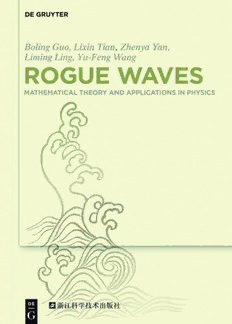Table Of ContentBolingGuo,LixinTian,ZhenyaYan,LimingLing,Yu-FengWang
RogueWaves
Also of interest
VanishingViscosityMethod.SolutionstoNonlinearSystems
BolingGuo,DongfenBian,FangfangLi,XiaoyuXi,2017
ISBN978-3-11-049528-7,e-ISBN978-3-11-049427-3
StochasticPDEsandDynamics
BolingGuo,HongjunGao,XuekePu,2016
ISBN978-3-11-049510-2,e-ISBN978-3-11-049388-7
NonlinearEquationswithSmallParameter
NikolaiTarkhanov,SergeiGlebov,OlegM.Kiselev,2017
ISBN978-3-11-033554-5,e-ISBN978-3-11-033568-2
NonlinearDynamics.Non-IntegrableSystemsandChaoticDynamics
AlexanderBorisov,2017
ISBN978-3-11-043938-0,e-ISBN978-3-11-043058-5
DeGruyterSeriesinNonlinearAnalysisandApplications
JürgenAppelletal.(Eds.)
ISSN0941-813X
Boling Guo, Lixin Tian, Zhenya Yan, Liming Ling,
Yu-Feng Wang
Rogue Waves
Mathematical Theory and Applications in Physics
MathematicsSubjectClassification2010
Primary:37K10,37J35,37K15;Secondary:70H06,81R12
Authors
Prof.BolingGuo Prof.ZhenyaYan
LaboratoryofComputationalPhysics ChineseAcademyofSciences
InstituteofAppliedPhysicsand InstituteofSystemsScience
ComputationalMathematics KeyLabMathematicsMechanization
6HuayuanRoad 55ZhongguancunEastRoad
HaidianDistrict HaidianDistrict
100088Beijing 100190Beijing
People’sRepublicofChina People’sRepublicofChina
[email protected] [email protected]
Prof.LixinTian AssociateProf.LimingLing
NanjingNormalUniversity SouthChinaUniversityofTechnology
SchoolofMathematicalScience WushanRD.,TianheDistrict
CenterforEnergyDevelopment 510641Guangzhou
210023Nanjing People’sRepublicofChina
People’sRepublicofChina [email protected]
[email protected]
Dr.Yu-FengWang
InstituteofAppliedPhysicsand
ComputationalMathematics
6HuayuanRoad
HaidianDistrict
100088Beijing
People’sRepublicofChina
[email protected]
ISBN978-3-11-046942-4
e-ISBN(PDF)978-3-11-047057-4
e-ISBN(EPUB)978-3-11-046969-1
Set-ISBN978-3-11-047058-1
LibraryofCongressCataloging-in-PublicationData
ACIPcatalogrecordforthisbookhasbeenappliedforattheLibraryofCongress.
BibliographicinformationpublishedbytheDeutscheNationalbibliothek
TheDeutscheNationalbibliothekliststhispublicationintheDeutscheNationalbibliografie;detailed
bibliographicdataareavailableontheInternetathttp://dnb.dnb.de.
©2017WalterdeGruyterGmbH,Berlin/Boston
Typesetting:IntegraSoftwareServicesPvt.Ltd.
Printingandbinding:CPIbooksGmbH,Leck
Coverimage:ChongGuo
@Printedonacid-freepaper
PrintedinGermany
www.degruyter.com
Contents
1 TheResearchProcessforRogueWaves 1
1.1 TheResearchProcessforRogueWavePhenomenon 1
1.2 SomeFamousExperimentsofRogueWaves 5
1.3 ResearchMethodandPhysicalMechanismofRogueWaves 9
1.3.1 MethodologyofRogueWaves 9
1.3.2 PhysicalMechanismofRogueWaves 10
1.4 MechanismsofRogueWaves 12
1.4.1 LinearMechanismsofRogueWaves 12
1.4.2 NonlinearMechanismsofRogueWaves 17
1.5 RogueWaveSolutionsforNonlinearPartialDifferentialEquations 21
1.6 OpticalRogueWaves 26
1.7 FinancialRogueWaves 28
1.8 NonautonomousRogueWaveSolutions 28
2 ConstructionofRogueWaveSolutionbytheGeneralizedDarboux
Transformation 30
2.1 TheClassicalDarbouxTransformation 30
2.2 GeneralizedDarbouxTransformationfortheClassicalKdVEquation 32
2.3 DarbouxTransformationforN-CoupledFocusingNLSEquation 35
2.4 RogueWaveSolutionsfortheTwo-ComponentNLSEquation 37
2.4.1 RogueWaveSolutionsfortheTwo-ComponentNLS
Equation 37
2.4.2 Bright-DarkBreatherandRogueWaveSolutions 41
2.5 GeneralizedDarbouxTransformationforNLSEquation 45
2.5.1 GeneralizedDarbouxTransformation 46
2.5.2 Higher-OrderRogueWavesinDeterminantForms 50
2.5.3 MathematicalCharactersoftheRogueWaveSolutionsfor
StandardNLSEquations 55
2.6 GeneralizedDarbouxTransformationforDNLSEquation 59
2.6.1 DarbouxTransformation-I 59
2.6.2 DarbouxTransformation-II 63
2.6.3 Reductions 66
2.6.4 GeneralizedDarbouxTransformations 67
2.6.5 GeneralizedDarbouxTransformation-II 69
2.6.6 High-OrderSolutionsforDNLSEquation 72
3 ConstructionofRogueWaveSolutionbyHirotaBilinearMethod,
Algebro-geometricApproachandInverseScatteringMethod 81
3.1 HirotaBilinearMethod 81
3.1.1 RogueWaveSolutionfortheNLSEquation 81
3.1.2 RogueWaveSolutionfortheDS-IEquation 98
VI Contents
3.2 ReductionfromtheKPEquation 105
3.3 Algebro-geometricReductionApproach 109
3.3.1 Relationship Between Fredholm Determinant and
(-Function 110
3.3.2 WronskianSolutions 112
3.3.3 ConstructionofRogueWaveSolution 116
3.4 InverseScatteringMethodandRogueWaveSolution 118
3.4.1 DirectProblem 119
3.4.2 ScatteringMatrix 120
3.4.3 InvolutionRelation 120
3.4.4 JumpsoftheEigenfunctionsandScatteringDataAcrossthe
BranchCut 122
3.4.5 TimeEvolution 123
3.4.6 InverseProblem 124
3.4.7 DarbouxTransformationandRogueWaveSolutions 127
4 TheRogueWaveSolutionandParameters
ManaginginNonautonomousPhysicalModel 135
4.1 IntroductiontotheRogueWaveSolution 135
4.2 Space-TimeModulationNonlinearSchrödingerEquation 137
4.2.1 One-DimensionalNonlinearPhysicalModel 137
4.2.2 SymmetryAnalysis-SimilarityTransformationandSimilarity
Solution 137
4.2.3 OneDimensionalSelf-SimilarityOpticalRogueWave
SolutionandItsParameterAnalysis 139
4.3 (3+1)-DimensionalSpace-TimeModulationGross–Pitaevskii/NLS
Equation 144
4.3.1 Three-DimensionalNonlinearPhysicalModel 144
4.3.2 SymmetryAnalysis-SimilarityTransformationandReduction
System 146
4.3.3 SimilarityVariable,ConstraintConditionandVelocity
Field 147
4.3.4 Three-DimensionalSelf-SimilarRogueWaveSolutionsand
ItsParametersRegulation 148
4.4 GeneralizedInhomogeneousHigher-OrderNonlinearSchrödinger
EquationwithModulatingCoefficients 152
4.4.1 SymmetryReductions–TransformationandHirota
Equation 154
4.4.2 Determining Similarity Variables and Controlled
Coefficients 156
4.4.3 DarbouxTransformationfortheHirotaEquation 159
4.4.4 OpticalRogueWaveSolutions 160
Contents VII
4.5 Two-DimensionalBinaryMixturesofBose–Einstein—Condensates 165
4.5.1 Two-ComponentGross–PitaevskiiEquations 165
4.5.2 SymmetryReductionAnalysis 166
4.5.3 Determining Similarity Variables and Controlled
Coefficients 168
4.5.4 TypesofNonlinearInteraction 170
4.5.5 Self-SimilarVectorRogueWaveSolution 171
4.6 Two-DimensionalNonlocalNonlinearSchrödingerEquation 176
4.6.1 Two-DimensionalNonlocalNonlinearModel 176
4.6.2 Two-DimensionalVariableSeparationReduction 177
4.6.3 Two-DimensionalRogueWave-LikeSolution 178
4.7 TheGeneralizedAblowitz–Ladik–HirotaLatticewithVariable
Coefficients 184
4.7.1 DiscreteNonlinearPhysicalModel 184
4.7.2 Differential-Difference Similarity Reductions and
Constraints 186
4.7.3 Determining the Similarity Transformation and
Coefficients 187
4.7.4 NonautonomousDiscreteRogueWaveSolutionsand
Interaction 188
Bibliography 193
1 The Research Process for Rogue Waves
1.1 TheResearchProcessforRogueWavePhenomenon
Roguewaveisalsonamedasfreakwave,monsterwave,extremewave,killerwave,
giantwave,etc.Itisdifficulttogiveafullexplanationofroguewave,duetoitscom-
plex phenomenon. Figure 1.1 shows us the dramatic appearance of the rogue wave
whichwasdownloadedfromtheInternet.Theauthoritystatementinoceanography
isthatitdevelopsfromtheoceansuddenlywithhighamplitude,whichappearsfrom
nowhereanddisappearswithoutatrace.Nowadays,suchnonlinearphenomenonhas
beenobservedinnonlinearoptics,Bose–Einsteincondensates(BEC),atmospherics,
superfluidandevenfinance. Ithasarousedtheattentionofscientistsfrom oceano-
graphy, physics and other nonlinear fields, since the term “freak rogue waves” was
firstcoinedbyDraper[1]in1965.
Forcenturies,roguewavehasbeenseenasthesealegendandapartofthemarine
folkculture. Intheocean,rogue waves,like adeep-seamonster,engulfsailorsand
shipswithoutanytrace,whichcausedalotofmaritimedisasters.
In 1933, in the Pacific Northwest, USA warship Ramapo encountered the tallest
roguewaveeverrecorded,with34m(112ft)height,whichwasvisuallymeasuredby
thecrewsonthedeck[2].
Since 1952, in the Indian Ocean, at least 12 cases of ships encountering rogue
wave have been recorded, near the Aga DeGeneres stream and along the coast of
South Africa. One miserable case is that, on June 13, 1968, the tanker World Glory
encountered a rogue wave, which broke the tanker into two parts (as seen in Fig-
ure1.2)andcausedthedeathof22crews,whenthetankerwasalongtheSouthAfrican
coast[3].
In1966,theMichelangelocruiseship,duringthevoyagefromItalytotheUnited
States, suddenly encountered a huge wave with 24 m height. The wave tore a hole
inthesuperstructure,smashedtheheavyglass, andmadeacrewmemberandtwo
passengersdie.
In1978,Munich,aGermanbarge,sankintheAtlanticOcean.Thetwistedwreck-
ageindicatesthatitwasdestroyedbyahugewave.
In1980,aroguewavewith25mheightwasphotographedbyPhilippeLijour,the
firstmateoftheFrenchtankerEssoLanguedoc,neartheseaoftheeasternportcity
DurbanofSouthAfrica(Azania).AsseeninFigure1.3,ahugewaterholewasobserved
clearly.
In 1984, a rogue wave attacked the 2/4-A oil platform of Norwegian Ekofisk oil
field,whichwaslocatedaboveaveragesealevelof20m.Inthisaccident,thewallof
theplatform’scontrolroomwasdestroyed,producingastandstillfor24hours[4].
In 1986, aUS warship SS Spray suffered three consecutive burstsof waves with
approximately25mheightintheseaofCharleston[5].Ahighlyasymmetricalrogue
wavewasalsoobservedasshowninFigure1.4,whichwasshotfromthewarship.

